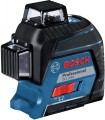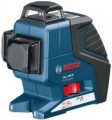Measurement range
The range at which the device remains fully operational without the use of additional receivers (see below); in other words, the radius of its action without auxiliary devices.
In some models, a range may be specified that shows the minimum (
3 cm,
5 cm) and maximum measurement ranges. But in most cases, only the maximum value is indicated.
The specific meaning of this parameter is determined by the type of instrument (see above). So, for optical levels, the measurement range is the greatest distance at which the operator can normally see the divisions of a standard leveling staff. For laser levels, this parameter determines the distance from the device to the surface on which the mark is projected, at which this projection will be easily visible to the naked eye; and in rangefinders we are talking about the greatest distance that can be measured. Typically, the measurement range is indicated for ideal conditions - in particular, in the absence of impurities in the air; in practice, it may be less due to dust, fog, or vice versa, bright sunlight "overlapping" the mark. At the same time, tools of the same type can be compared according to this characteristic.
Note that it is worth choosing a device according to the range of action, taking into account the features of the tasks that are planned to be solved with its help: after all, a large measurement range usually significa
...ntly affects the dimensions, weight, power consumption and price, but it is far from always required. For example, it hardly makes sense to look for a powerful laser level at 30-40 m if you need a device for finishing work in standard apartments.Measurement range (with receiver)
The longest measurement range provided by a laser level (see “Type”) when using a special receiver with a photocell.
Thanks to its sensitivity, such a receiver is able to respond even to a weak laser beam, the mark from which is no longer visible to the naked eye; At the same time, the area of the photocell is quite large, and special indicators make it possible to determine the exact position of the mark. Among other things, this significantly expands the range of action of the level - the measurement range with a receiver is usually several times greater than without it. On the other hand, such equipment inevitably affects the overall cost of the device; and in some models the receiver
is not included in the package at all; it must be purchased separately. However, the second option also has its advantages: you do not need to immediately pay for an additional accessory, it can be purchased later, when a real need arises, while some models allow you to choose the optimal receiver model from several options at your discretion.
Note that the receiver can be useful not only for increasing range; These points are described in detail in paragraph “Included parts”.
Accuracy
Accuracy is described as the maximum deviation from the true value of the measured parameter, which the device can give if all the rules for its operation and the corresponding measurements are observed. In both rangefinders and levels, this parameter is usually designated for a certain distance — for example, 3 mm at 30 m; but even for one manufacturer, these "control" distances may be different. Therefore, in our catalog, the accuracy of all devices is recalculated for 1 m distance; with such a record, for the example above, it will be 3/30 \u003d 0.1 mm / m. This makes it easier to compare different models with each other.
It is also worth mentioning that the meaning of the "accuracy" parameter for different types of measuring instruments (see "Type") will be different. For optical levels, it is described in the "SKP" paragraph above. For laser levels of all types, accuracy is the maximum deviation of the mark from the true horizontal (or vertical, if such a function is provided), and for the horizontal, we can talk about both moving the mark up / down and turning it. In rangefinders, this characteristic describes the maximum difference (both in "plus" and "minus") between the readings of the device and the actual distance to the object.
Anyway, the smaller the error, the better; on the other hand, accuracy significantly affects the price of the device. Therefore, it is necessary to choose a specific model for this parameter, taking into account the...specifics of the planned work. For example, for a relatively simple repair in a residential apartment, a high-precision tool is unlikely to be required; and recommendations for more complex tasks can be found in specialized sources, ranging from expert advice to official instructions.
Auto power off
The time after which the device turns off by itself completely if the user does not perform any action.
See above for more information on auto power off; and his time has a double meaning. On the one hand, if this time is short, then the idle time of the device will be minimal, which helps to save energy. On the other hand, too frequent auto-shutdown (with subsequent switching on for work) is also undesirable — it increases the wear of components and reduces the resource, and it is not always convenient for the user. So manufacturers choose the time, taking into account the balance between these moments, as well as the general class and purpose of the device. So, in some rangefinders, this indicator does not even reach a minute, although in most such devices it is in the range from 3 to 8 minutes; and in some professional devices (primarily levels), the auto-off time can be 30 minutes or more (up to 3 hours).
Diode emission
The wavelength of the radiation emitted by the LED of the level or rangefinder; this parameter determines primarily the colour of the laser beam. The most widespread in modern models are LEDs with a wavelength of about 635 nm — at a relatively low cost, they provide bright red radiation, giving a well-visible projection. There are also green lasers, usually at 532 nm — the marks from them are even better visible, but such LEDs are quite expensive and rarely used. And radiation with a wave longer than 780 nm belongs to the infrared spectrum. Such a laser is invisible to the naked eye and is poorly suited for leveling, but it can be used in rangefinders — of course, with a viewfinder (see "Type" for more details).
Operating time
Operating time of the device on one battery charge.
It is worth considering that these figures are quite approximate, since the operating time is measured under certain standard conditions (usually continuous operation at nominal power). And since in practice conditions may differ markedly, the operating time may turn out to be noticeably shorter or longer than stated. In addition, if the device uses replaceable batteries (AAA, AA and the like), then autonomy will also depend on the quality of the specific batteries/accumulators. Nevertheless, based on the data specified in the characteristics, it is quite possible to evaluate the capabilities of specific models and compare them with each other: the difference in the declared operating time, as a rule, proportionally corresponds to the difference in practical autonomy under the same conditions.
We also note that the operating time is specified mainly for levels; in rangefinders another parameter is more often used - the number of measurements (see below).

